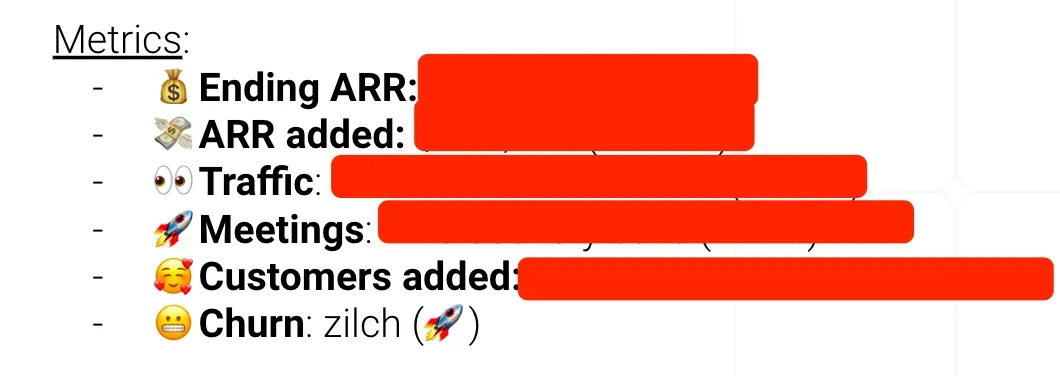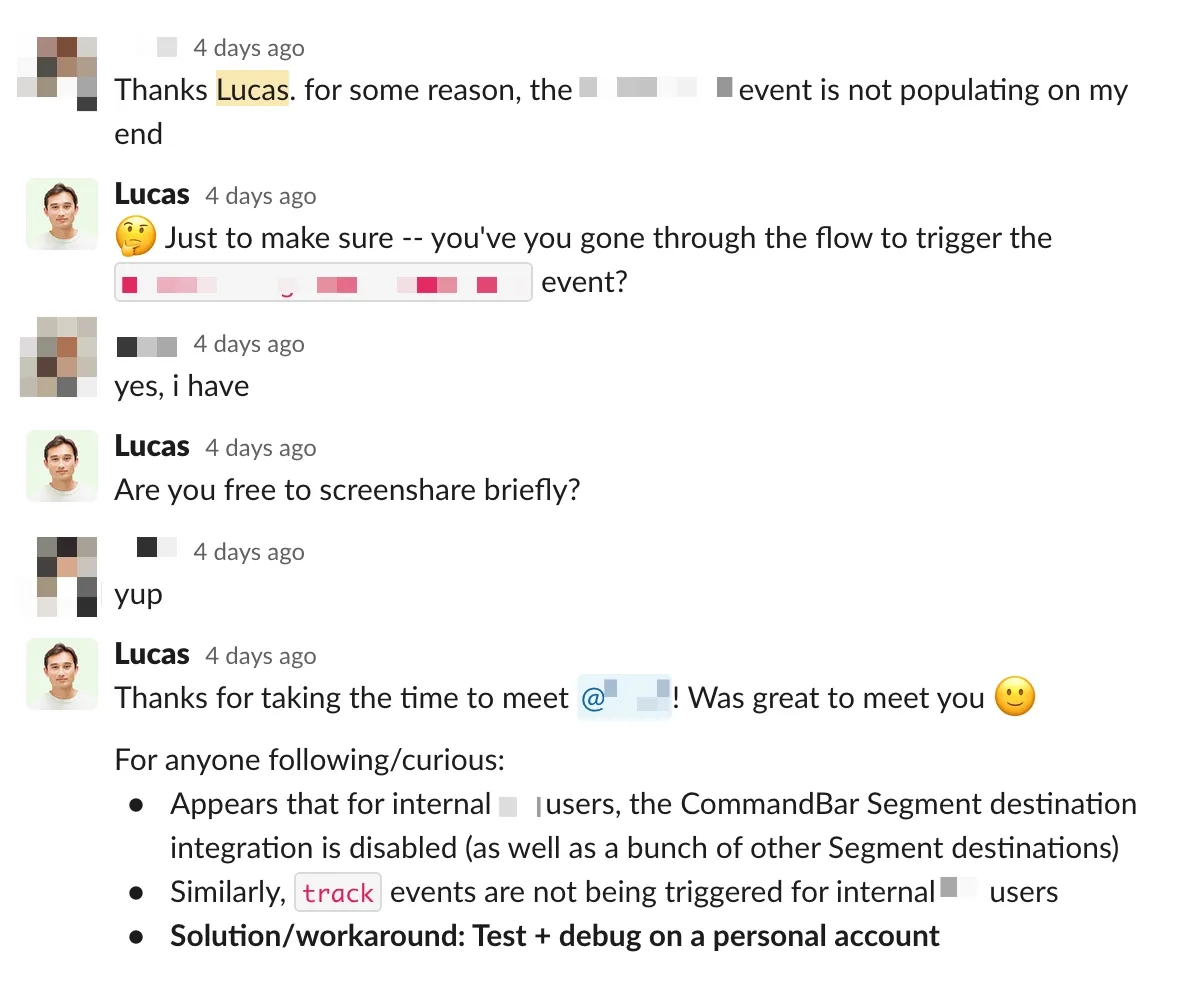In Q2 of this year (2023) Command AI celebrated a milestone that might be my proudest professional moment (more special than raising $24M or hitting revenue targets) – zero churn.

For the SaaS finance aficionados reading, this was gross dollar churn. That means that we didn't lose a single paying customer (and no one downgraded either).
This isn’t a humblebrag post. We’ve had churn in the past (though thankfully not a lot) and have been experimenting with how to best serve our customers for pretty much the entirety of our existence as a company.
Here are some tactics we’ve leaned into at Command AI to keep our customers happy.
1. Maximize human interaction
Ironically, much of our product’s purpose is helping users use software products without requiring human assistance (usually from a support team). That said, we basically try to spend as much time with our customers as possible.
When a customer encounters a bug (usually this happens in Slack, where we have 1:1 channels with most of our customers, but the same is true of our email and chat support channels), a human on our team responds and usually asks to huddle or screenshare to get more context on the problem.

We set up recurring meetings with all of our customers at whatever the most frequent cadence is that seems reasonable. The cadence ranges from weekly (our favorite!) to every quarter. Sometimes we skip the meetings, but the point is that we have a recurring way to hear what’s on our customers’ minds.
When customers are using software, they don’t typically narrate your thoughts to you; they typically only reach out when;
- Something important is broken that is in their way or
- They can’t figure out how to do something important.
They won’t tell you the vague idea they had about how to use your product that they couldn’t decide was possible. They also won’t tell you about a growing sense of frustration with the number of bugs they’re encountering. Or praise how a specific support interaction was handled. Those are all things you hear in meetings, especially when you ask open-ended questions.
Speaking of open-ended questions…
2. Always be discovering
Everyone who works with customers at Command AI (which is almost 100% of our company) receives training on how to do what’s often called “customer discovery”.
If you don’t work in sales, you might not know what “discovery” refers to. Typically, “discovery” is the first stage in a sales process where the seller gathers useful information about the buyer that will help shape the sales journey (or disqualify the prospect if the discovery leads the seller to believe they aren’t a good fit for what is being sold).
“Discovery” has a kind-of mercenary implication (”I’m going to use this information to sell to you”), but in this context, it’s basically just customer ethnography. We want to understand everything that is happening with our customers: their usage of Command AI (the good and bad and vague), what else is going on at their company, and (to the extent relevant) how their individual jobs are going (we’d love to help someone get over the edge on a promotion by shipping something that influences the P&L!).
The best way to do discovery is to take every opportunity to ask customers open-ended questions. What is an open-ended question? An open-ended question is a deliberately vague question that encourages the person receiving it to answer in whatever way they see fit.
For example, if a customer says, “I want feature X”, you could consider responding in one of two ways:
- “Sure, when do you need it by?”
- “How were you thinking of using this?”
The first question will likely get a specific answer ("next month would be great"). The second question opens up a much wider aperture of conversion ("oh, well, this other day I was having this problem where Y, and I figured this could help by X”).
Boom!
Now you have way more information that can help you support the customer more in the future (maybe you have a better solution for problem Y) and you’ve also gotten important information that will help you build the solution (since customers are notoriously bad at coming up with solutions to their own problems).
3. Realistic promises
We get a lot of feature requests. In the early days, when we had only a few handfuls of customers, we would just say yes to everything. As you scale, that strategy becomes counterproductive.
Customers much prefer hearing, "We will do that, but probably not until next quarter," or even "We tried that, and it doesn't work" instead of, "Oh yeah, we'll build it exactly like you asked for!"
As we grow and work with more companies, we gain credibility to push back on requests that we don't think represent good solutions. “We prototyped that with a few of our customers and didn’t see the results that we wanted” is a wonderful way to push back on a request:
- It gives a reason why you’re skeptical of the request (instead of something more implicit like “interesting, we’ll add to the backlog!”)
- It positions you as an expert (see below for more on that). While it’s often the right reflex to think “the customer is king”, customers are not gods — they are experts in the problems they encounter in their jobs, but not always in solution. You are the solutions expert (in some domain at least) — that is why you are being hired.
- It builds trust. You don’t want your customers to think of you as a yes-man. Sharing your true opinion will almost always result in your customers gaining more respect for you as a colleague.
4. Become a trusted guide for your problem space
While we live and die by the quality of our software, we also provide some free consulting for our customers. Part of our flywheel at Command AI is working with lots of world-class software companies, learning from them, and reflecting those learnings in the product. Sometimes though, what is most useful to a customer is getting feedback on a feature. Or getting a recommendation for another vendor.
With all the time we spend with our customers, our team has grown into a group of world-class Product thinkers who have learned through osmosis many times over — working here is like doing a series of internships at a bunch of companies all at once.
The same is true of any company that is doing a good job of spending time with customers and asking open-ended questions. Not all of the information you learn will be directly related to your job in the moment, but it will start to make you an expert in your field.
The advice to provide free consulting might be controversial. After all, no SaaS CEO wants a P&L consisting of low-margin services revenue versus juicy high-margin software revenue.
While it’s true that you should recognize if customers are buying your product just for your consulting (that would imply your business is less scalable because you need to spend time with customers to earn your revenue), we find that generally making ourselves available to give our customers’ advice is always worth the time. In the spirit of rule 2 above, it gives us more opportunities to spend time with them. It also increases the odds our customers trust us, which helps with rule 3. And of course, it builds a relationship of mutual support and trust.

















